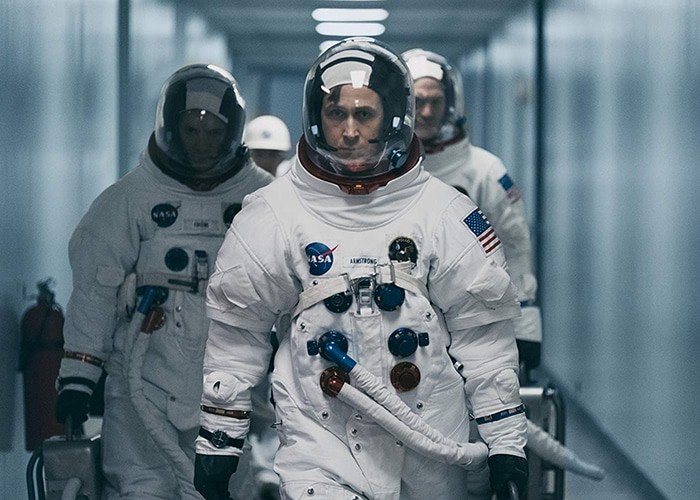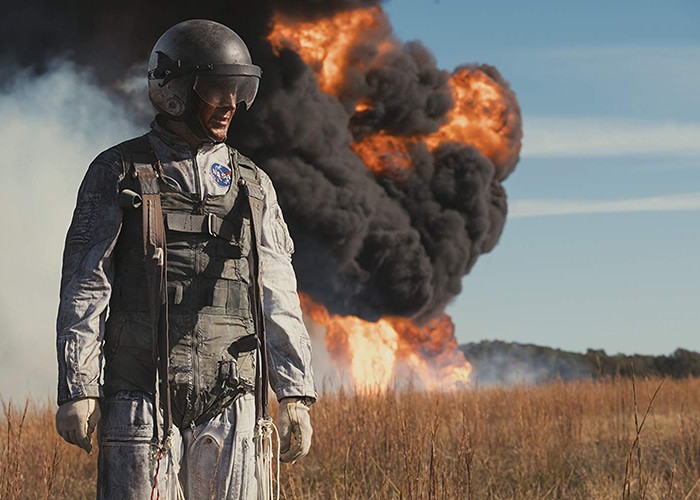The first thing you notice about Damien Chazelle’s First Man is that it looks markedly different from other space movies. So much of what we see feels like its part of a documentary: the edits are rough, the images often grainy, and the camera spends much of its time convulsing in scenes of space flight, making these moments feel like the handheld work of a cinema verité filmmaker rather than coming from the confident stance of a seasoned Hollywood cinematographer like Linus Sandgren. That effect is, of course, exactly what Chazelle intended: both the director and his key crewmembers have cited non-space movies like The Battle of Algiers, The French Connection and the works of direct cinema luminaries D.A. Pennebaker, Frederick Wiseman and the Maysles Brothers as pivotal influences on the making of their film.
First Man evidently shares broad strokes with these seminal examples of realist cinema, but much of its visual and audio DNA can also be traced to a documentary that shares its specific subject matter, too. Made up entirely of archival footage of the Apollo missions that took place between 1968 and 1972, Al Reinert’s Oscar-nominated 1989 documentary For All Mankind is more than just a record of what the men who went to the moon saw. Shot by the astronauts themselves on handheld 16mm cameras, Mankind eschews the scientific approach lunar documentaries usually take, and goes one step further, too, refusing to include any contextual framing throughout its 80-minute runtime. The only voices we hear come via the narration by astronauts who undertook the missions we see (including Neil Armstrong’s Apollo 11), and even they are left anonymous. There are no talking heads or introductions here; the astronauts’ voices float, unattributed, over the images they captured. (Only the Criterion version of the film identifies the astronauts via secondary subtitling.)
The intentions of Reinert, who fashioned the film out of some 600 hours of unseen footage that was gathering dust in NASA’s basements, are clear: he wants to train his audience’s focus entirely on the combination of words and images he has so painstakingly collated and cut together (with editor Susan Korda) to form one cohesive emotional account of a trip to the moon. He makes it easy to fall into total absorption. Every element of space flight is rescued from the isolating mires of science-speak by the profound reflective tone of the narration, which turns this mind-bending endeavour not into something rationally comprehensible – one of the film’s strengths is the sense of wonder it restores in desensitised viewers – but almost spiritual.

Mankind’s anonymising approach is clearly at odds with Chazelle’s very specific, very individual story. And lest we over-stretch the resemblance between the two films, there are other stark differences between them, too: First Man is undoubtedly a grittier portrait of space travel, including as it does so much evidence of the tragic consequences of man’s lunar ambitions, while Mankind devotes much less attention than First Man to the domestic impact of space travel (what Chazelle refers to as his film’s split “moon and kitchen” focus).
But if we look deeper, Mankind’s imprint on Chazelle’s film is clear. Reinert’s documentary is often cited as the essential viewing partner to any space movie, but it feels uniquely complementary to Chazelle’s. Take the music for starters. There is something about music and outer space that makes the score an essential component in any half-decent space movie (or YouTube video): maybe because it’s a comfort to overlay these foreign images with earthly noises, or because the idea of a sound vacuum is too terrifying to comprehend and demands to be filled with something reassuringly familiar. However you rationalize it, music by Justin Hurwitz (working on First Man) and Brian Eno (for Mankind) does the job, and well. Their success is interlinked, too: while First Man’s soundtrack draws in places on musical conventions already associated with space — there are notes of 2001: A Space Odyssey in one particular waltz number — it’s the ghost of Brian Eno’s ethereal synthesized compositions for Mankind that is most present in the alien sounds of Hurwitz’s more common theremin- and Moog-heavy pieces.
Music aside, First Man feels cut from the same cloth as Reinert’s documentary. Both films devote themselves to immersing viewers in the astronauts’ perspective, rendering everything else peripheral. For Reinert, working solely with a wealth of archival footage, that decision perhaps came more naturally than for Chazelle, whose decision to stay loyal to the perspective of Neil (Ryan Gosling) for nearly every frame in First Man must have presented quite the logistical challenge.
First Man pulls it off, however, and because of that, it shares Mankind’s reluctance to impress upon us the magnitude of Apollo 11 by sandwiching the drama in between perspective-breaking, jargonistic scenes. That’s not to say Chazelle’s movie doesn’t impress upon us the magnitude of Apollo 11, but rather that it does so via a quasi-documentary visual style that calls back to the NASA footage in Reinert’s documentary.
The first thing that strikes you about both For All Mankind and First Man is their shared insistence on emphasising the contradictions in scale involved with lunar travel. Sandgren shoots Neil and his fellow crewmembers extremely close-up as they’re stuffed into their capsules like a tin of sardines, the camera invading what little elbowroom the men have left. These claustrophobia-inducing scenes were intentionally shot on 16mm cameras because of their functionality – they’re easily manoeuvrable in confined spaces like the capsules – but also because Chazelle consciously sought to emulate the agile, immersive look of the 16mm archival footage on display in For All Mankind. Indeed, the pre-take-off footage in Reinert’s film imparts that same squeezing sense of space, as multiple engineers work to slot astronauts into the inches of room allotted for them in the capsule.
In contrast, the rockets themselves are made no small thing. The real astronauts’ footage makes plain just how imposing these immense constructions were: in one stand-out scene, we ride with the men in a cage-like elevator, watching floor after floor fall away beneath us, apparently climbing steep heights although we’re not making a dint on the rocket, which still towers up and beyond the frame. Chazelle takes similar pains to illustrate their colossal presence in several exterior scenes, including one in which Neil, Buzz Aldrin (Corey Stoll) and their crewmates crane their necks trying to take in the loftiness of it.
There’s a shot in First Man borrowed directly from its partner scene in Mankind, too: strapped in and locked away in the tiny capsule, Gosling mimics real-life astronaut Ken Mattingly in looking out of a window near his head, through which he spies the crescent moon, hanging in anticipation for its first visitor. While the camera convulses with the ferocity of take-off, Neil keeps his eyes trained on his destination. You could almost overlay the moment with Mattingly’s words, spoken over the same scene in Mankind: “I know [mission control] are doing their job right, because the moon’s right straight ahead and that’s where we’re pointed.”

But perhaps most striking is the way both films capture the sheer force of mission launch and the alien nature of the moon — and with that impart a comprehension that what these men are doing is almost elementally unnatural. Committed as the film is to emulating Neil’s perspective, Chazelle is reluctant to shoot earlier take-offs from an external position, but for Apollo 11’s launch, he’s willing to break with that convention. The rocket almost becomes a fire-breathing character of its own: Sandgren’s camera moves outside Neil’s capsule to take in the billowing flames, clouds of smoke and the hail of launch debris produced by take-off in a canny realization of the words of one of Mankind’s astronauts: “This thing out here…you have the feeling it’s alive.” Even the air around the rocket seems sentient, too: it quakes as it’s rent apart by the violence of flight, as if to protest: this is not natural. Mankind presents much the same picture; both scenes look like they’ve been plucked out of a Vietnam movie, or a cinematic adaptation of Dante’s Inferno. Nothing that looks this destructive should be productive, but space flight is a paradox in that sense. It’s a topsy-turvy idea, sending a man to the moon, so it’s only right that we up-end our own instincts about danger before it can happen.
When they finally touch down, both films give us ample opportunity to appreciate the stark visual eccentricity of the moon. First Man morphs into IMAX for its lunar scenes, but even if For All Mankind maintains its heavy grain and boxy aspect ratio throughout, the sweepingness and isolation of the environment are made clear to us in the eerie music that plays over panning shots that take in the moon’s dunes, the sheer drop of the horizon and the “blacker than black” sky that hangs above.
The magnitude of the risk involved in a mission like Apollo 11 is something you feel with your chest, and it’s a key component in building the heroic myths of men like Neil. But equally important are the astronauts themselves, and its striking that neither of these movies seeks to gild their astronauts as prodigal rocket scientists or as uniquely brave lionhearts. In fact, they suggest the opposite: these were normal men doing the job handed to them, no better-suited to the task than anyone else who had the same workhorse mindset and above average devotion to duty than they did. Emblematic of that philosophy is the scene in First Man when Neil is awaiting his turn to be interviewed for a position on the program: it’s not the aggressively macho military men who succeed, but the unassuming, introverted civilian. Gosling’s sedate performance is crucial to First Man’s proclamation of everyday heroism, but there is a scrappiness underlying all of Josh Singer‘s characters that makes them feel like descendants of Mankind’s astronauts. When Neil is assuring the gathered press that NASA intends their mission to be successful, it’s almost as if he’s channelling the clear-headed tenacity of Mankind’s Mattingly, who sums up the astronauts’ prevailing spirit when he narrates his part in Apollo 16: “I don’t know how to make [space flight] work. I don’t how to do most of this mission. But […] I can assure you that my piece of it is gonna work, and it won’t fail because of me.”
Scenes like this, as well as those depicting Neil’s fraught family and work life, lower First Man’s hero down from lofty heights, and in doing so, make the story of the first man on the moon a very human one. That’s a feat it shares with Mankind: via the astronauts’ sincere introspection and unguarded shooting style, we’re made party to the apprehension, the thrill, the goofy humour – “Hey John, did you make those little footprints over here?” – and the unbridled wonder and envy parcelled up in an endeavour as extraordinary as extra-terrestrial exploration.
As our own Max Covill wrote in his review of First Man, the movie’s strengths lie in its spectacle. But whatever its flaws, in drawing on For All Mankind for inspiration, First Man also earns itself some of that film’s profundity and authenticity.
The post The Deep Impact of ‘For All Mankind’ on ‘First Man’ appeared first on Film School Rejects.
0 comments:
Post a Comment